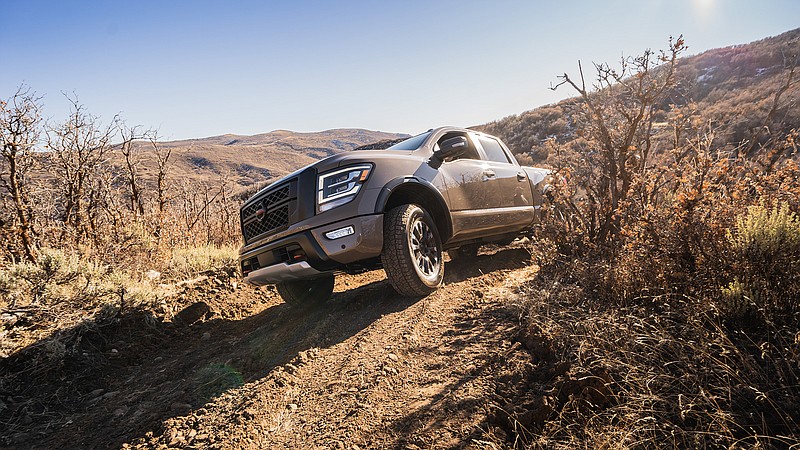One of my favorite movie lines comes from Roger Rabbit.
"I'm not bad," said the hare's voluptuous 'toon wife. "I'm just drawn that way."
That image kept floating through my mind this week as I put a 2021 Nissan Titan Pro-4X through its paces on a 260-mile jaunt through the forested hills of North Central Arkansas. Beautiful Blonde Bride and I chose to explore the Ouachita River watershed to escape a horde of workers finishing - finally! - a year-long series of unfortunate events that constituted home remodeling.
The Titan, which Nissan spells in all caps because it looks like I'm yelling at you, is, incidentally is one of the more American pickups. Manufactured and assembled in Canton, Mississippi, the Titan has more American parts content than the Ram Classic, Chevrolet Silverado, or Toyota Tacoma, according to cars.com
THE (sorry, didn't mean to raise my voice) most American-made truck? The Honda Ridgeline of Lincoln, Alabama, closely follows the Ford Ranger. The rest are way behind.
Solid foundation
One of the few things to go well in 2020 was Nissan's redesign of the Titan. Feature-filled, it checks all the boxes for power, technology, comfort, and capability - and is certainly pleasing to the eye - and yet, it has some flaws.
Pickups are all about power and the Titan's lone powertrain option is a homerun. A 5.6-liter V8 with best-in-class 400 horsepower and 413 pound-feet of torque, matched to a nicely sorted 9-speed transmission, accelerates like a prairie fire and provides shifts as smooth as a PGA putting green.
It can haul up to 9,200 pounds, a solid B-plus for a quarter-ton pickup. With variable-valve and direct-injection technology, the 5,800-pound truck delivered 16.8 mpg, a C-minus in today's pickup world.
My friend, Tim Esterdahl, whose channel, Pickup Truck and SUV Talk, is officially a big deal on YouTube, says his 2021 Ford F-150 hybrid usually gets up to 24 mpg, city and highway. That's nearly 50 percent better than the Titan and might turn out to be a big deal if a government bent on saving the planet jacks up the price of carbon fuels, something Tim would not like.
I'm not saying it's going to happen, but I do get paid to think about these things.
It is also relevant to note that Nissan trucks have the best warranties in the business and that local dealers are offering hefty discounts.
Cozy cabin
The big trend in pickups the last decade has been toward luxury, and the Titan sort of keeps with that trend. First-class accommodations are created with careful craftsmanship and premium finishes. Large Zero-Gravity seats, which enhance posture for long-distance comfort are large and remained congenial throughout a day exploring winding and rough back roads.
I came to know the voluminous rear well, thanks to Oreo. While his tiny brother snoozed like an old man, riding comfortably on a pillow on Mama's lap, Oreo, the world's only 60-pound Shiatsu (it's a long story), fended for himself in the back.
He loved the open rear sliding window, or simply putting his arm on the armrest and looking out the side window or up through the dual-panel panoramic roof.
He soon figured out the association between the button and the window, so I had to child-proof that. Still, the big dog never laid down, not even after the endless curves convinced him to evacuate his Sonic jumbo popcorn chicken and tater tots. While I became intimately associated with his stomach contents, the boys and the bride cheerfully traipsed off for a jaunt through Joplin Campground, which is smack-dab in the middle of Lake Ouachita and one of the prettiest places on this planet.
The cabin is filled with cupholders and bins and charging ports. While it is all nicely assembled, from the driver's seat it feels disjointed. The switch arrangements look like they were done by a committee with revolving membership. The button to turn on the steering wheel heater, for example, is closer to the passenger than the driver.
More pointedly, the dash appears to be the result of shoehorning modern technology into components designed 10 years ago. Dark-orange switchgear lighting clashes with white lighting of the infotainment center and dash cluster. I'm sure an owner would soon know where everything is but the layout is anything but intuitive.
On balance, though, it is a Jessica Rabbit cabin: filled with nice things though hard to locate at times - and luxuriously quiet. Nissan did a very nice job isolating passengers from noise, vibration, and harshness.
Off-road champ
I am not going rock crawling with the family onboard, but in the fall, I took a Titan out on a challenging course. Like every Nissan truck I've driven through mud, over rocks, and up blind climbs, it was superb under demanding conditions.
On this journey, which included sections of unpaved and muddy roads, I appreciated how a flip of a dial quickly put me in four-wheel-drive and the excellent traction that provided.
When I worked myself into a place that called for turning around, I came to appreciate the standard rear automatic braking, which kept me from implanting a tree stump into the exhaust tip.
Safety a close second
Innovative safety gear is gaining traction in the auto industry, and Nissan is one of the leaders. The Titan comes standard with Nissan Safety Shield 360 - a suite of six advanced driver-assist systems: automatic emergency braking with pedestrian detection, blind-spot warning, rear cross-traffic alert, lane departure warning, high beam assist, and class-exclusive standard rear automatic braking.
A rear-door alert, which reminds the driver to check the rear seats - as if I could ever forget Oreo - is standard on all Nissans.
Although that sounds comprehensive, it is far from it. The two most important innovations, in terms of avoiding accidents, are dynamic cruise control and lane-keep assist. The first, which our tester had, avoids nose-and-tail collisions, the most common form of accident. The other keeps a vehicle in its lane.
Did you hear about the New Year's Day accident in which nine people - including seven children - burned to death? According to the California Highway Patrol, a 28-year-old man driving a Dodge car near Fresno, California, veered off the highway, overcorrected and hit a Ford pickup head-on.
That's the accident that lane-keep assist avoids. That is also the answer to people who don't want this technology because they want CONTROL! Here's the thing: The car ALWAYS pays attention. (Yes, I did mean to raise my voice. As a reporter, I covered too many fatal rollovers and head-on collisions caused by momentary inattention and panicked over-correction.
Our Titan only had a lane-keep warning. It's a nice system with a haptic interface - the driver's seat buzzes on the side crossing either the side marking or center stripe. That sounds nice, but in practice it is useless.
Most people become aggravated with the warnings and turn the system off: Indeed, that was the state the system was in when the truck was delivered to me. That is always the case. I have yet to have been delivered a vehicle with a lane-keep warning with the system on. People do not understand that the system is not the problem, they are.
Lane-keep assist - not warning - is standard on every vehicle Toyota sells. Some manufacturers dial these systems in better than others. Left to their own devices, some vehicles lurch from side to side, while others seem dynamically balanced between the two sides and stay perfectly in their lanes. Perhaps the best I've driven was in a Nissan Murano.
In the second decade of the 20th century, a proper vehicle should be able to keep itself a safe distance behind others and in its lane.
A $60,640 truck that can't do that? C'mon, Jessica.


